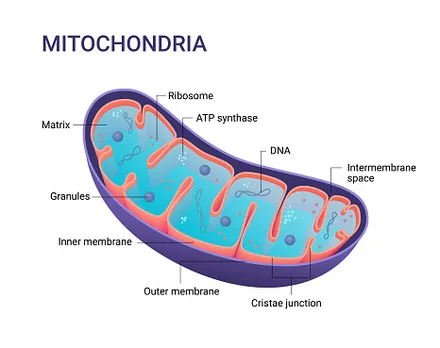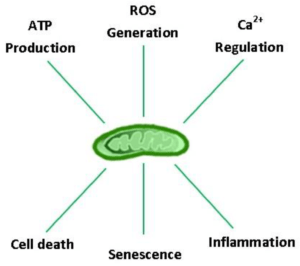Mitochondria, small membrane-bound organelles present in eukaryotic cells, are known as the “powerhouses of the cell” due to their primary role in generating abundant energy in the form of ATP. Acting as the cell’s energy currency, this ATP is indispensable for fueling diverse cellular processes.
Notably, mitochondria possess their own distinct genetic material, separate from the nucleus, enabling them to produce specific proteins independently. Although their primary function is energy production, mitochondria have additional responsibilities. They store calcium ions, crucial for cell signaling, and partake in cell growth, apoptosis, and heat production. Furthermore, they contribute to intercellular signaling, facilitating various physiological processes.
With a typical round to oval shape and varying in size, mitochondria are essential for the survival of human cells. They enable aerobic respiration, converting oxygen and nutrients into ATP, ensuring high-energy output. In conclusion, mitochondria are vital organelles that generate ATP, serve as energy sources, possess unique genetic material, participate in diverse cellular functions, and contribute to overall cell growth and vitality.
Structure of Mitochondria
The structure of mitochondria can be described as follows:

Outer Membrane:
- Composed of proteins and phospholipids.
- Contains porins, which are proteins that allow the movement of small molecules and ions into and out of the mitochondrion.
- Enzymes involved in fatty acid elongation and adrenaline oxidation are also found on the outer membrane.
Intermembrane Space:
- The space between the outer and inner membranes.
- Provides a location for various enzymatic reactions and protein functions.
Inner Membrane:
- Composed of phospholipids and proteins.
- Impermeable to most molecules due to the absence of porins.
- Special transport proteins facilitate the movement of metabolites into and out of the matrix.
- ATP synthase, the enzyme responsible for ATP production, is located in the inner membrane.
Cristae:
- Irregular folds of the inner membrane.
- Increase the surface area of the inner membrane, providing more space for chemical reactions, especially oxidative phosphorylation.
- Play a crucial role in energy production.
Matrix:
- Fluid-filled space within the inner membrane.
- Contains numerous enzymes involved in the Krebs (TCA) cycle and fatty acid cycles, which generate energy.
- Houses mitochondrial DNA (mtDNA), RNA, ribosomes, and calcium granules.
- Essential for ATP production.
Mitochondria are typically small, ranging from 0.75 to 3 micrometers, and they are not visible under a microscope unless stained. They possess two membranes, an outer membrane and an inner membrane, each with distinct functions. The outer membrane allows the passage of small molecules, while the inner membrane is impermeable to most molecules and requires specific transporters. The inner membrane is organized into cristae to increase the surface area for energy production. The matrix, located within the inner membrane, contains enzymes, mtDNA, and other molecules necessary for ATP synthesis.
Different cell types have varying numbers of mitochondria, with energy-demanding cells having a higher abundance. They can undergo fission and fusion, constantly changing their network-like structure. In sperm cells, the mitochondria are spiraled in the midpiece and provide energy for tail motion.
Function of Mitochondria
The mitochondria, in addition to their well-known role in energy production, carry out various important functions in cells. Some of these functions include:
1. Energy Generation:
- Mitochondria produce ATP (adenosine triphosphate), the primary energy currency of cells, through oxidative phosphorylation in the inner membrane.
- The citric acid cycle or Krebs cycle, which occurs in the mitochondria, plays a crucial role in generating ATP by extracting energy from carbohydrates, fats, and proteins.
2. Cell Death (Apoptosis):
- Mitochondria play a critical role in initiating and regulating apoptosis, a process of programmed cell death.
- They release cytochrome C, which activates caspase enzymes involved in cell destruction during apoptosis.
3. Heat Production:
- In certain conditions, such as cold environments, they can generate heat through a process called non-shivering thermogenesis.
- Tissues like brown adipose tissue contain mitochondria specialized for heat production.
4. Calcium Storage and Regulation:
- Mitochondria play a role in maintaining calcium homeostasis by rapidly absorbing and storing calcium ions until they are needed.
- Calcium is essential for various cellular processes, including neurotransmitter release, muscle function, hormone signaling, and blood clotting.

Mitochondria also contribute to other functions such as:
- Maintaining the intracellular environment by storing caspases involved in apoptosis and regulating calcium levels.
- Mitochondrial dysfunction and mutations in mitochondrial DNA or nuclear genes related to mitochondria can lead to a range of medical conditions collectively known as mitochondrial diseases.
- Mitochondrial dysfunction has been implicated in several age-related conditions and diseases, although the exact role of mitochondria in aging is still being studied.
Overall, mitochondria are multifunctional organelles that not only produce energy but also play vital roles in cell homeostasis, cell death, heat production, and calcium regulation.
Mitochondrial DNA
Mitochondrial DNA (mtDNA) is a circular chromosome found within them, cellular organelles responsible for energy production and metabolic functions. In humans, mitochondria, along with their mtDNA, are inherited exclusively from the mother. While most DNA is housed in the nucleus, mitochondria contain a small amount of their own genetic material. The mtDNA spans about 16,500 DNA building blocks and carries 37 genes essential for proper function.
Thirteen of these genes provide instructions for enzymes involved in oxidative phosphorylation, a process that generates ATP, the cell’s primary energy source. The remaining genes encode transfer RNA (tRNA) and ribosomal RNA (rRNA), which assist in protein synthesis. MtDNA is physically and transcriptionally distinct from the nuclear genome, having evolved from a bacterial ancestor through endosymbiosis.
Regulation of mtDNA transmission and replication is crucial during early development, impacting the health and viability of offspring. Assisted reproductive technologies like somatic cell nuclear transfer (SCNT) and cytoplasmic transfer have shed light on the significance of mtDNA regulation. Introducing foreign mtDNA can compromise genetic identity and metabolic capacity, leading to health issues similar to mitochondrial disorders.
Understanding and rectifying the regulation of mtDNA transmission and replication in cloned embryos could have broader applications in the livestock industry and biomedical research, offering potential advancements in these fields.
Interesting facts about Mitochondria
- Mitochondria have their own DNA and are believed to have originated from ancient symbiotic bacteria that formed a mutually beneficial relationship with early eukaryotic cells.
- They are responsible for producing over 90% of the energy required by cells through the process of oxidative phosphorylation.
- They are highly dynamic structures that constantly undergo fusion and fission processes to adapt and respond to cellular needs.
- In most animals, mitochondria are inherited solely from the mother, as sperm cells generally do not pass their mitochondria to the offspring during fertilization.
- Mutations or dysfunction in mitochondria can lead to a wide range of diseases collectively known as mitochondrial diseases, affecting various organs and systems in the body.
- Apart from energy production, it play important roles in calcium regulation, apoptosis (programmed cell death), heat production, and cell signaling.
- The number of mitochondria within a cell can vary depending on its energy requirements, with highly active cells like muscle cells containing thousands of mitochondria.
- Brain cells have a high concentration of mitochondria as they require large amounts of energy, accounting for about 20% of the body’s total energy consumption.
- Certain types of fat cells, known as brown adipose tissue, contain an abundance of mitochondria that generate heat to help regulate body temperature, particularly in newborns and hibernating animals.
- The symbiotic relationship between early eukaryotic cells and mitochondria is speculated to have had a crucial impact on the evolution of complex life forms. Without mitochondria’s energy production, multicellular organisms might not have evolved.